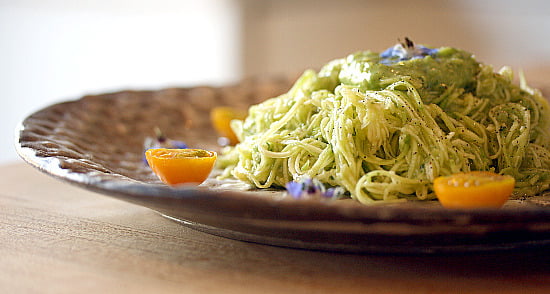 |
| Someone else's more gourmet picture - to entice you! |
Did I mention a serving this dish will get you at least 10% of ALL your vitamins and minerals except D, B12, Sodium and Selenium -- in only about 250 calories?? Sprinkle on some sea salt for sodium. You can add a good amount of selenium and B12 you non-vegetarians can pair with some sardines, salmon or lamb.
This can be done a day in advance.
Preheat your oven to 375 degrees and wash your spaghetti squash. Place it on a baking sheet or in a pan and cook for about 50-60 minutes. A knife should easily cut into it when it is done. Set aside and let cool.
Here is what this looks like.
 |
| Look at that beautiful avocado! |
 |
| I forgot my parsley and added my tomatoes in before sauce |
Dice your tomato and add to a small skillet with water. Saute briefly to warm the tomatoes and increase their lycopene. Toss on top of your pasta.
And you're done! Actually, the sauce would be equally as delicious on raw zucchini noodles if you want to keep everything raw. If you like some crunch, just reserve a little of your zucchini and dice into small bits and sprinkle on your noodles.
This should make 2 servings, plus lots of extra spaghetti squash for later!
ESTIMATED NUTRITION PER SERVING:
(using 1 cup spaghetti squash per person, 1 TBsp olive oil total recipe, parsley, 3 cloves garlic, half of a medium avocado and 1 cup diced tomato per person)
- 260 calories
- 32g carbs; 10g fiber; 13g sugar
- 16g fat (half olive oil, half avocado); 2g saturated fat
- 7g protein
VITAMINS/MINERALS:
- 100%+: Vitamin K, Vitamin C
- 40-50%: Vitamin A, B6, Manganese, Potassium, Folate
- 20-25%: Riboflavin, Magnesium, Niacin, Copper, Pan. Acid











































